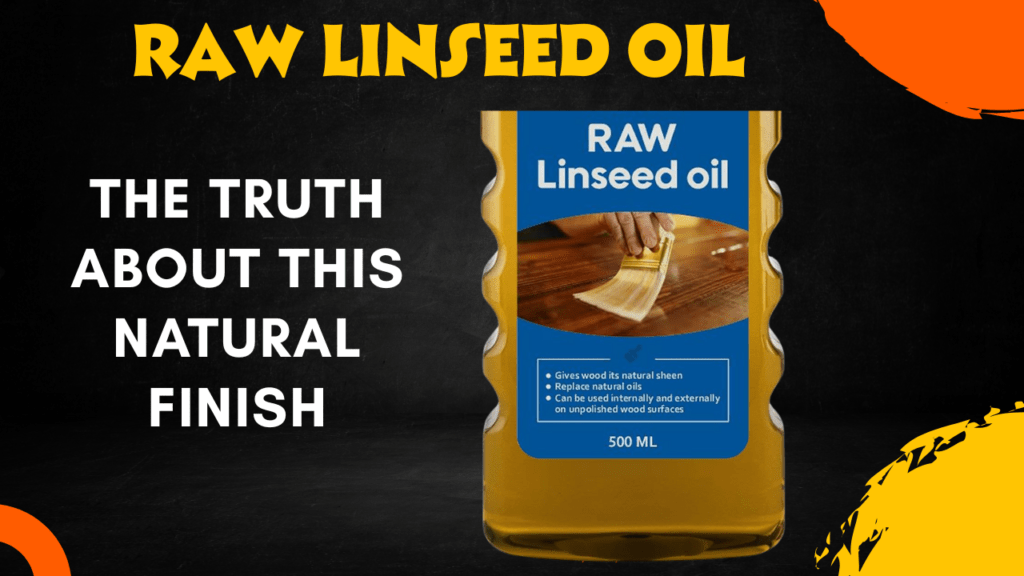
When it comes to natural oils, raw linseed oil stands out as one of the oldest and most trusted options for finishing and protecting surfaces. Extracted from the seeds of the flax plant, this simple yet powerful oil has been used for centuries in woodworking, leather care, artwork, and even metal preservation.
Today, despite modern synthetic finishes, many craftsmen, furniture restorers, artists, and DIY enthusiasts still turn to raw linseed oil for its natural appeal and traditional benefits.
In this blog, we’ll take a deep look at what raw linseed oil is, its uses, advantages, drawbacks, and safety tips, so you have a complete picture before using it in your projects.
What is Raw Linseed Oil?
Raw linseed oil is pure oil pressed directly from flaxseeds without the addition of chemicals or drying agents. Unlike boiled linseed oil (which is mixed with solvents or additives to dry faster), raw linseed oil is completely natural and non-toxic.
It has a clear, light golden color and a slightly nutty smell. Since it contains no artificial compounds, it is safe for wood that comes into contact with food, such as cutting boards, kitchen utensils, wooden bowls, and countertops.
However, there’s one major downside—raw linseed oil dries very slowly. Depending on temperature and humidity, it can take days to weeks for a layer to cure fully.
Uses of Raw Linseed Oil
Raw linseed oil is incredibly versatile and has various traditional and modern uses:
Wood Protection
- One of the most common applications is as a wood finish.
- It penetrates deep into the wood fibers, strengthening and protecting them from within.
- It enhances the natural grain of the wood, giving it a warm, rich finish.
Cutting Boards and Kitchenware
- Since it is a food-safe oil, it’s used to treat wooden spoons, chopping boards, bowls, and countertops.
- It provides protection without introducing harmful chemicals.
Leather Treatment
Raw linseed oil can be applied to leather to keep it supple, prevent cracking, and add a natural sheen.
Metal Preservation
When used on iron or steel, raw linseed oil forms a protective coating that resists rust. Many traditional tools and weapons were preserved this way.
Art and Painting
Artists have used the linseed oil as a base for the oil paints for many centuries. It helps pigment bind to the canvas and gives paintings depth and durability.
Benefits of Raw Linseed Oil
Why do so many people still prefer raw linseed oil today? Here are some of the main advantages:
All-Natural & Eco-Friendly: Contains no harmful chemicals or additives.
Food-Safe: A safe option for kitchen woodware and surfaces that come into contact with food.
Deep Penetration: It soaks into the fibers of wood, protecting from inside out and preventing warping or cracking.
Enhances Wood Beauty: Brings out the natural grain while giving the surface a warm, slightly glossy finish.
Versatile: It Can be used on the wood, leather and even on the metals.
Affordable & Widely Available: Easily found in hardware and art supply stores.
Drawbacks of Raw Linseed Oil
Despite its many benefits, raw linseed oil is not perfect. Here are some challenges you may face:
Slow Drying Time – This is the biggest drawback. A single coat of raw linseed oil may take up to a week to dry completely, depending on conditions. Multiple coats mean longer waiting times.
Yellowing Over Time – With age, it tends to darken and give surfaces a yellowish tint. For some projects, this can be undesirable.
Limited Water Resistance – While it improves durability, raw linseed oil alone does not make wood waterproof. For outdoor use, additional protection may be required.
Requires Maintenance – Raw linseed oil finishes must be reapplied regularly to keep surfaces protected and looking fresh.
How to Apply Raw Linseed Oil
To get the best results, follow these simple steps when applying raw linseed oil:
Prepare the Surface
Sand the wood smoothly and remove dust. On leather, clean with a damp cloth.
Apply a Thin Coat
Use a clean soft cloth or brush to rub a small amount of oil onto the surface. Avoid excess oil.
Allow to Absorb
Let the oil soak in for 30–60 minutes. Wipe off any surface residue to prevent a sticky finish.
Drying Time
Allow the first coat to dry completely (which may take several days).
Repeat for Multiple Coats
Apply additional coats for improved durability, always allowing full drying time in between.
Safety Precautions
While raw linseed oil itself is non-toxic, its application process can be risky if safety rules are ignored.
Spontaneous Combustion Risk: Rags soaked in linseed oil can heat up and catch fire if left crumpled. Always spread used rags flat outside to dry fully, or store them in a sealed metal container filled with water.
Proper Ventilation: When applying indoors, ensure windows are open for proper airflow.
Patience is Key: Don’t rush the drying process—this is where most people get frustrated.
Raw vs. Boiled vs. Polymerized Linseed Oil
It’s essential to understand the difference between the three common types:
Raw Linseed Oil:
100% natural, food-safe, slowest drying. Best for kitchen woodware and eco-friendly projects.
Boiled Linseed Oil (BLO):
Contains additives to dry faster (in 1–3 days). Not recommended for food-contact surfaces.
Heat-treated, dries faster than raw but remains food-safe. Often used for furniture and larger wood projects.
Final thoughts
Raw linseed oil may not be the fastest or most convenient finish, but its natural, food-safe, and eco-friendly qualities make it a timeless choice. It is especially valued for wood finishing, leather care, and metal protection.
Although you need patience due to its slow drying time, the results are rewarding—your wood gets a rich, beautiful, and long-lasting finish that synthetic products can’t quite replicate.
For anyone looking to balance tradition with sustainability, raw linseed oil is a reliable and environmentally friendly option. Whether you’re a woodworker, restorer, or DIY enthusiast, keeping a bottle of this classic oil in your workshop is always a wise idea.

